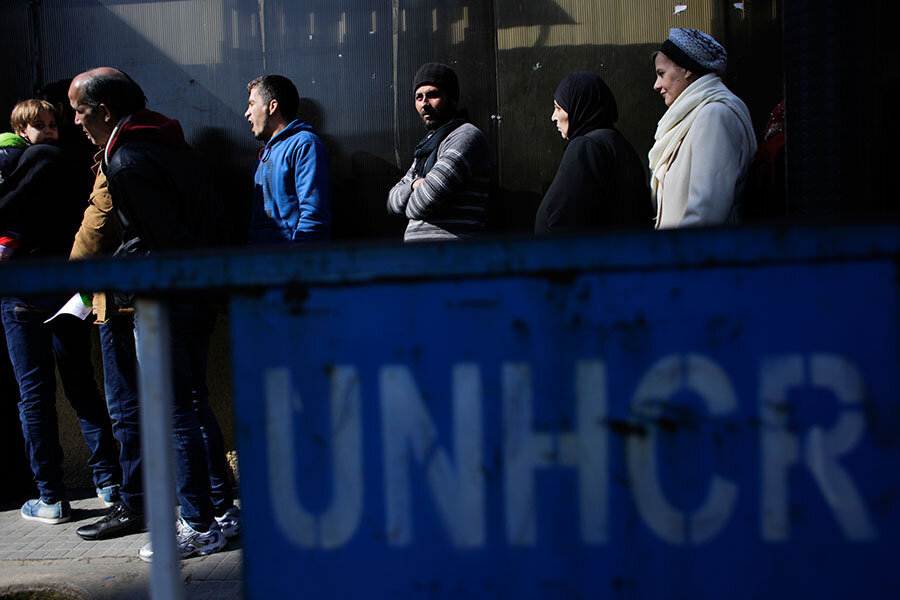Trump pushes for 'safe zones' in Syria: Could they work?
Loading...
| United Nations, N.Y.
President Trump has been sharply critical of European countries – particularly Germany – for opening borders and taking in millions of refugees from Syria and other conflict zones.
Better to avoid the security risks – to both the refugees and to the countries that would host them – and help those displaced by war stay home, Mr. Trump says.
His solution? “Safe zones,” where displaced families could live securely without having to become refugees. In the case of Syria, Trump has directed the Pentagon and State Department to come up with a plan by the end of April for havens that would be protected by the United States with security and financial participation of regional powers.
Trump has already taken the idea to some regional leaders and continues to tout the idea as part of a Middle East policy in which local governments would take on more of the responsibility for initiatives in the region.
The US “will absolutely do safe zones in Syria,” Trump said in an interview with ABC News last month.
But the idea of safe zones –originally pushed by Hillary Clinton during the Obama presidency – gives many diplomats and experts pause. In the 1990s, safe zones in Bosnia and Rwanda often only exposed refugees to greater risks. The danger is that the zones become targets for other groups in the country who do not want them to succeed. For its part, Russia has already cautioned the United States against such a plan.
Moreover, at a time when the Trump administration is attempting to block Syrian refugees from entering the US indefinitely, there is concern that the plan is really more about keeping refugees out than about making them safe at home.
The United Nations' refugee agency, UNHCR, says it stands ready to work with the Trump administration on any initiative that improves the security and well-being of the world’s record number of displaced people. But officials caution that the track record on safe havens is not encouraging.
“We believe that history gives us some stark and relatively recent lessons in the effectiveness of safe zones,” says Christopher Boian, a spokesperson for UNHCR based in Washington. Citing Bosnia and Rwanda, he adds that “we would be very concerned that people seeking security would end up exposed to the very violence they are trying to flee.”
The challenges
As secretary of State, Mrs. Clinton failed to persuade President Obama to champion safe zones. Mr. Obama was leery of the military involvement the plan would require.
The prospect has grown only more complex as outside forces like Russia and Iran have stepped up involvement, the Syrian opposition has fragmented further, and the self-declared Islamic State has established itself.
“The objective of this kind of project may be described as fundamentally humanitarian, but the reality is that any number of parties, starting with the Assad regime and the Islamic State, are going to see it as a threat, and that’s going to make it a target instead of a safe place,” says Daniel Byman, a professor of security studies at Georgetown University in Washington.
Both the Syrian government and the Islamic State would be concerned that the haven could become a training ground for opposition fighters. As a result, the haven would almost certainly require ground forces to protect civilians, Professor Byman adds.
Those ground forces would face a constellation of groups opposed to outside forces on their lands, others say.
“Guarantees for the safety of civilians would be further challenged by the multitude of armed actors exercising varying degrees of military or other control over a complex patchwork of territory,” says Mr. Boian of UNHCR.
Voices of caution
For these reasons among others, Byman says he expects a very cautious assessment of the proposal from the Pentagon and State Department.
“They’re certainly not going to so directly say, ‘No we can’t do this,’ but I do think we’ll see something like ‘Here are the options for doing this, and here are the difficulties that will be baked into each one of those options,’ ” Byman says. “And then I’d expect an ‘Oh by the way, did we mention we might end up fighting with the Russians if we do this?’ ”
Several diplomats at the UN say they took note of Russia’s recent admonition to Washington to “think about the potential consequences of establishing safe zones.” That suggests to them that Moscow could decide to veto any Security Council resolution Trump might seek to build international support for his safe zone plan.
Trump has always presented his “safe zones” plan in terms of what is best for the Syrian people, asserting they would be “happier” remaining home or close to home. But humanitarian experts say refugees are happiest where they are safe, can get work, and go to school – and that often means leaving home and even the region around home.
Moreover, Boian says no plan purporting to offer safety to displaced people in their home country should be conceived of as a means of fencing people in.
“We don’t want to see ‘safe areas’ being used to deny people fleeing armed conflict and persecution the right to seek asylum and safety,” he says.







